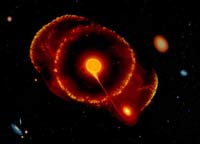Giant red star found with comet-like tail powerful to form planets
Astronomers discovered the tail by looking at ultraviolet images from the Galaxy Evolution Explorer telescope, orbiting the Earth. The pictures show the red giant star known as Mira, which has the same mass as our sun but is 400 times as large, dragging a comet-like collection of glowing dust that goes back 13 light-years.

Scientists yesterday described Mira as a kind of "Johnny Appleseed of the Cosmos," skipping through the Milky Way at 80 miles per second while strewing atoms of carbon, nitrogen, and oxygen -- elements that are the building blocks of new solar systems.
"All of the carbon in our muscles and all of the oxygen that we breathe every time we take a breath comes from red giant stars," Michael Shara, a professor of astronomy at Columbia University, said in a teleconference discussing the finding. "So this is the source of some of the material that's essential for life, and we're seeing it implanted across the galaxy right now."
Stars often swell and cool as they age, becoming red giants before exploding or collapsing, reports Boston Globe.
"I was shocked when I first saw this completely unexpected, humongous tail trailing behind a well-known star,'' said Christopher Martin of the California Institute of Technology in Pasadena, California.
"The process basically plants the seeds for new solar systems to form,'' said Mr Martin, the Galaxy Evolution Explorer's principal investigator.
Scientists said Mira's tail shed substances such as carbon, oxygen and other important elements needed for new stars and planets and even life to form, reports Melbourne Herald Sun.
The researchers suggest that because the star is moving at a relatively quick pace of 130 kilometers per second (or three times a bullet's speed) relative to the galaxy, it has compressed and heated the interstellar gas in front of it. This hot gas excited the cool, five-kilometer-per-second breeze of hydrogen molecules and heavier elements emanating from Mira, causing it to glow in the ultraviolet.
The team estimates that Mira A loses one millionth of the sun's mass a year, out of its total bulk of perhaps 1.5 solar masses.
Martin says ultraviolet tails may be quite common despite going unnoticed until now. The red giant phase awaits many smaller stars, including our own sun in four billion to five billion years, Scientific American reports.
Source: Agencies
Subscribe to Pravda.Ru Telegram channel, Facebook, RSS!




